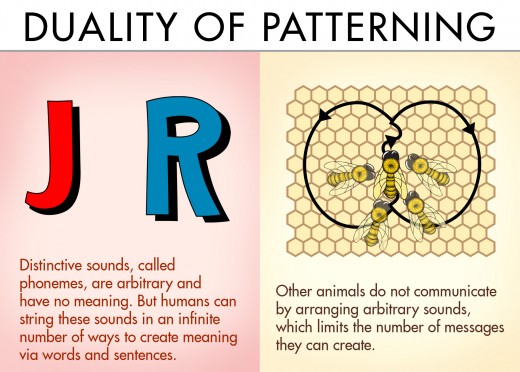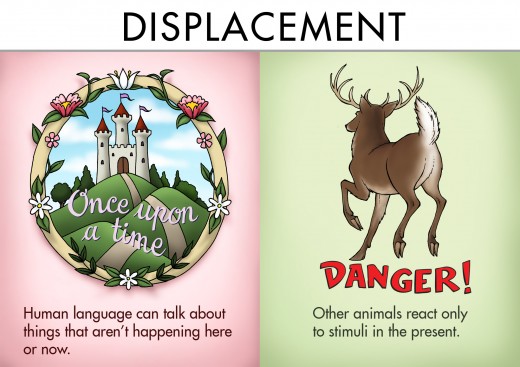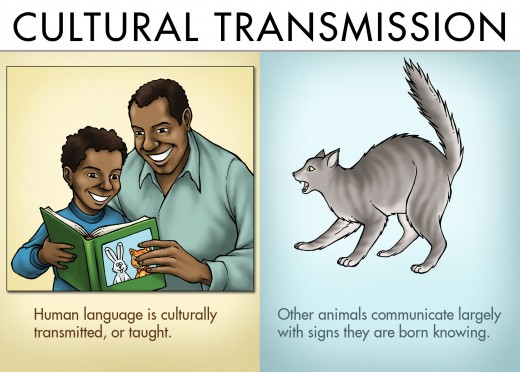




If someone asked you what separates humans from other animals, one of the first things that would probably come to mind is language. Language is so fundamental to human life that it's hard to imagine what life would be like without it. In fact, the original term for language referred to it as part of the body—language is derived from the Latin word lingua, meaning tongue. Barnett highlights the inseparability of language from man when he says, “Verbal communication is a condition of the existence of human society.”
But at the same time, other animals also communicate: Your cat may let you know when its hungry, ants use pheromones and sound to indicate social status and distress, bees dance to tell one another where to find honey, and chimpanzees can learn sign language.
So when we think of language as a way of setting ourselves apart, what is it about our language that is different than how other animals communicate?
In the video below, Professor Marc van Oostendorp of the Leiden University Centre for Linguistics discusses three of the major differences between human and animal communication; this article will examine these differences and more.
Human | Animal | |
|---|---|---|
Duality of Patterning | Distinctive sounds, called phonemes, are arbitrary and have no meaning. But humans can string these sounds in an infinite number of ways to create meaning via words and sentences. | Other animals do not communicate by arranging arbitrary sounds, which limits the number of messages they can create. |
Creativity | New words can be invented easily. | Animals have to evolve in order for their signs to change. |
Displacement | Humans can talk about remote, abstract, or imaginary things that aren't happening in their immediate environments. | Animal communication is context driven—they react to stimuli, or indexes. |
Interchangeability | Any gender of human can use the same languages. | Certain animal communications in the animal world can only be used by one gender of that animal. |
Cultural Transmission | Humans acquire language culturally—words must be learned. | The way that animals communicate are biological, or inborn. |
Arbitrariness | Human language is symbolic, using a set number of sounds (phonemes) and characters (alphabet), which allows ideas to be recorded and preserved. | Animal communication is not symbolic, so it cannot preserve ideas of the past. |
Biology | On a purely biological level, the human voice box and tongue are very unique, and are required to make the sounds we recognize as language. | Other animals have different biological structures, which impact they way they make sounds. |
Ambiguity | A word, or sign, can have several meanings. | Every sign has only one meaning. |
Variety | Human language can arrange words into an infinite number of ideas, sometimes referred to as discrete infinity. | Animals only have a limited number of combinations they can use to communicate. |
While many scholars may add to this list, this article will examine seven properties that are largely unique to human language: duality, creativity, displacement, interchangeability, cultural transmission, arbitrariness, and biology.
Duality

The primary difference is known as duality of patterning, or structure. Each human language has a fixed number of sound units called "phonemes." These phonemes are combined to make morphemes, the smallest unit of sound that contains meaning. Thus, language has got two levels of patterning that are not present in other animals' communication.
Creativity
Yet another distinctive feature is creativity. Human beings use their linguistic resources to produce new expressions and sentences. They arrange and rearrange phonemes, morphemes, words, and phrases in a way that can express an infinite number of ideas. This is also called the open-endedness of language. Animal communication is a closed system. It cannot produce new signals to communicate novel events or experiences.
Displacement

Human beings can talk of real or imaginary situations, places, or objects far removed from their present surroundings and time. Other animals, on the other hand, communicate in reaction to a stimulus in the immediate environment, such as food or danger. Because of this, human language is considered context-free, whereas animal communication is mostly context bound.
Interchangeability
Human language is interchangeable between sexes. But certain communications in animal world are performed only by one gender. For example, bee dancing is only performed by worker bees, which are female.
Cultural Transmission

Another important difference is that human language is culturally transmitted. Human beings brought up in different cultures acquire different languages. Man can also learn other languages via the influence of other cultures. Animals lack this capacity. Their communication ability is transmitted biologically, so they are unable to learn other languages.
Arbitrariness
Human language is a symbolic system. The signs, or words, in language have no inherent connection to what they signify, or mean (that's why one object can have so many names in different languages). These signs can also be written with the symbols, or alphabet, of that language. Both verbal and written language can be passed down to future generations. Animal communication is not symbolic, which means ideas cannot be preserved for the future.
Biology
Biological differences also play a vital role in communication. Human vocal cords can produce a large number of sounds. Each human language uses a number of those sounds. Animal and birds have entirely different biological structures, which impact the way they can form sounds.
Wait: largely unique to human language? Does that mean that other animals can display these properties?
It's a matter of debate. One of the most contested examples is Nim Chimpsky, a chimpanzee named after noted linguist Noam Chomsky, who was taught over 100 signs in sign language in the '70s. Turning hand gestures into meaning certainly displays arbitrariness. But Herbert Terrace, the psychology that led the study doubted that Nim had really learned a language. He noted that Nim very rarely signed spontaneously; instead, he would react to signs his teacher was making.
The idea below shows other contested examples of when the line between human and animal communication becomes blurred.

Website design / content / graphics by Fakhar Alam © 2015 Prof. Fakhar Alam